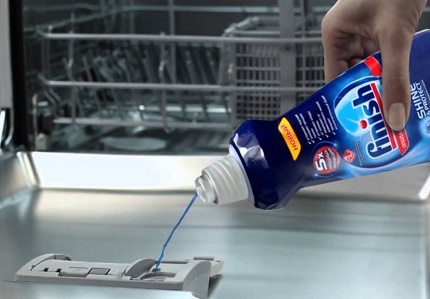
What is Rinse Aid for a Dishwasher?
Rinse aid is a liquid additive specifically designed for use in dishwashers. It is formulated to prevent water spots, streaks, and residue on your dishes and glassware.
When added to the dishwasher’s rinse cycle, rinse aid works by reducing the surface tension of the water, allowing it to flow off the dishes more easily and evenly.
This results in faster drying and spot-free, sparkling dishes.
Why Should You Use Rinse Aid?
Using rinse aid in your dishwasher offers several benefits that enhance your dishwashing experience.
Here are a few reasons why you should consider using rinse aid:
-
Improved Drying: Rinse aid helps to accelerate the drying process by ensuring water doesn’t cling to your dishes, leaving them perfectly dry and ready for use.
-
Spot and Streak-Free Results: By reducing water spots and streaks, rinse aid ensures your glassware and dishes maintain their pristine appearance.
-
Enhanced Shine: Rinse aid adds an extra sparkle to your dishes, making them look more appealing and presentable.
-
Prevents Residue Build-Up: The use of rinse aid prevents mineral deposits and detergent residue from sticking to your dishes, keeping them clean and spotless.
-
Faster and More Efficient Cleaning: Rinse aid allows the water to flow smoothly, reaching all the nooks and crannies of your dishes, resulting in a more thorough and efficient cleaning process.
How to Use Rinse Aid

Using rinse aid in your dishwasher is a straightforward process. Follow these simple steps to achieve optimal results:
Step 1: Check the Rinse Aid Dispenser
Before adding rinse aid, check if your dishwasher has a dedicated rinse aid dispenser. Most modern dishwashers come with a built-in dispenser located near the detergent compartment.
Step 2: Fill the Rinse Aid Dispenser
Open the rinse aid dispenser by twisting the cap or pressing the release button, depending on the model of your dishwasher.
Carefully pour the rinse aid into the dispenser until it reaches the “max” or “full” level indicated on the dispenser.
Step 3: Adjust the Rinse Aid Settings
Some dishwashers allow you to adjust the rinse aid dosage based on the water hardness level. Consult your dishwasher’s manual to determine the appropriate setting for your water hardness.
Step 4: Close the Rinse Aid Dispenser
Securely close the rinse aid dispenser, ensuring it is tightly sealed to prevent any leaks during the wash cycle.
Step 5: Run the Dishwasher
Load your dishwasher with dirty dishes, add the appropriate detergent, and select the desired wash cycle.
Start the dishwasher, and it will dispense the rinse aid during the rinse cycle automatically.
Can I use vinegar as a substitute for rinse aid?
While vinegar can be used as a natural alternative to rinse aid, it may not provide the same level of effectiveness in preventing water spots and enhancing drying as dedicated rinse aid products.
How can I troubleshoot if rinse aid is not working effectively?
If rinse aid is not working effectively, you can troubleshoot the issue by following these steps:
- Check the Rinse Aid Dispenser: Ensure that the rinse aid dispenser is filled correctly. Open the dispenser and make sure it is not empty or clogged.
If necessary, clean the dispenser to remove any residue or blockages.
-
Adjust the Rinse Aid Dosage: Some dishwashers allow you to adjust the rinse aid dosage. Consult your dishwasher’s manual to determine the appropriate setting for your water hardness.
Adjusting the dosage can help optimize the effectiveness of the rinse aid.
-
Verify Proper Dispenser Function: Ensure that the rinse aid dispenser is functioning properly. If the dispenser is not releasing the rinse aid during the rinse cycle, there may be a mechanical issue.
Refer to your dishwasher’s manual for troubleshooting instructions or consider contacting a professional for assistance.
-
Check Water Temperature: Verify that the water temperature in your dishwasher is appropriate.
If the water is too cool, it may affect the performance of the rinse aid. Check the dishwasher’s settings and adjust the water temperature if necessary.
-
Clean the Dishwasher: Over time, mineral deposits and residue can accumulate inside the dishwasher, affecting the effectiveness of rinse aid.
Clean the dishwasher regularly by running an empty cycle with dishwasher cleaner or a mixture of vinegar and baking soda to remove any build-up.
-
Evaluate Water Quality: The hardness of your water can impact the effectiveness of rinse aid.
If you have hard water, consider using a water softener or installing a water softening system to improve the overall performance of your dishwasher and rinse aid.
How often should I add rinse aid to my dishwasher?
The frequency of adding rinse aid to your dishwasher depends on the usage and the hardness of your water.
As a general guideline, it is recommended to add rinse aid whenever the indicator on your dishwasher alerts you to refill the dispenser.
Dishwashers usually have an indicator light or a display that notifies you when the rinse aid needs to be replenished.
Additionally, you can monitor the level of rinse aid in the dispenser by visually checking it every few weeks or after a certain number of wash cycles. If the dispenser appears empty or nearly empty, it’s a good time to add more rinse aid.



